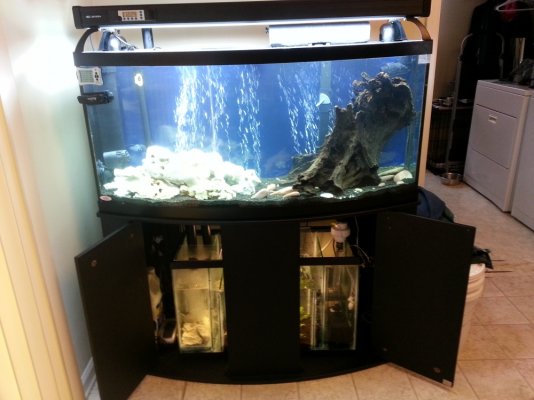MrPhazeWun
Aquarium Advice Apprentice
Hey all,
I've custom made a freshwater refugium for my 72 gallon bow front out of a 29 gallon aquarium. Due to the lack of information I've been able to find on a freshwater refugium set up, I've gone with steam plants (Wisterias) and lights on 24/7. For a light, I've gotten a plant bulb and a common bulb reflector (the ones you could buy in walmart for around $6). The plants are booming, but with the plants, so is the algae growth. As if late, I've seen some hair algae on the plants.
I'm not sure if many have had experience with this issue or not, or if it sounds logical to be concern about this, since at the end of the day, the algae will absorb nitrates as well.
My concern I guess would be to have algae infestation in my main display. FYI, my main display is a mbuna tank, and the lights are only one at feeding time for only 4 hours a day (due to my concern of algae infestation and they are T5 H/O 6500K)
So I guess I'm asking for any information/advice on Freshwater Refuges as far as setup and maybe and information about these sort of issues, if there is any out there.
Thanks in advance,
Luis
I've custom made a freshwater refugium for my 72 gallon bow front out of a 29 gallon aquarium. Due to the lack of information I've been able to find on a freshwater refugium set up, I've gone with steam plants (Wisterias) and lights on 24/7. For a light, I've gotten a plant bulb and a common bulb reflector (the ones you could buy in walmart for around $6). The plants are booming, but with the plants, so is the algae growth. As if late, I've seen some hair algae on the plants.
I'm not sure if many have had experience with this issue or not, or if it sounds logical to be concern about this, since at the end of the day, the algae will absorb nitrates as well.
My concern I guess would be to have algae infestation in my main display. FYI, my main display is a mbuna tank, and the lights are only one at feeding time for only 4 hours a day (due to my concern of algae infestation and they are T5 H/O 6500K)
So I guess I'm asking for any information/advice on Freshwater Refuges as far as setup and maybe and information about these sort of issues, if there is any out there.
Thanks in advance,
Luis

